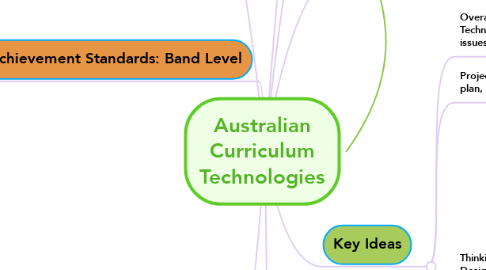
1. Achievement Standards: Band Level
1.1. ACARA F-2
1.1.1. Band Achievement standard - Students are provided with opportunities to experience designing and producing products, services and environments. Students explore and investigate technologies − materials, systems, components, tools and equipment − including their purpose and how they meet personal and social needs within local settings.
1.1.1.1. Elaborations- Additional information provided to the teachers to assist with teaching the content descriptors.
1.1.1.2. Content Descriptors- Targeted learning outcomes that the students are required to meet through the course of their learning.
1.1.1.3. Achievement standard- This information provided sets the guidelines for teachers that this is what their students must achieve by the end of the year.
1.2. ACARA 3-4
1.2.1. Band Achievement standard- Teachers build on previous knowledge, skills and processes developed in previous years.Students develop a sense of self and ownership of their ideas and thinking about their peers and communities and as consumers. Students explore and learn to harness their creative, innovative and imaginative ideas and approaches to achieve designed products, services and environments.
1.2.1.1. elaborations
1.3. ACARA 5-6
1.3.1. Band Achievement standard Students in these year levels critically examine technologies − materials, systems, components, tools and equipment − that are used regularly in the home and in local, national, regional or global communities, with consideration of society, ethics and social and environmental sustainability factors. Students consider why and for whom technologies were developed.
1.3.1.1. elaborations
1.4. Year 1- Achievement Standard- School Curriculum and Standards Authority Students identify people that produce common products and services and recall some simple stages of the production process,
1.4.1. People produce familiar products and services to meet personal and community needs (ACTDEK001)
2. General capabilities/ Cross curriculum priorities
2.1. Prepares students to live and work in the 21st Century
2.2. 1- Literacy-
2.3. 2- Numeracy
2.4. 3-ICT
2.5. 4- Critical and Creative Thinking
2.6. 5- Personal and Social capability
2.7. 6- Ethical Understanding
2.8. Intercultural Understanding
2.9. Cross Curriculum Priorities
2.9.1. Sustainability
2.9.1.1. Aboriginal and Torres Strait Islander Histories and Cultures
2.9.1.1.1. Asia and Australia's engagements with Asia
3. Resource Library
3.1. Teaching ideas- http://www.teachingideas.co.uk/dt/contents.htm
3.2. Teaching apps- http://www.teachingappz.co.uk/listingtype/dt-2/
3.3. TechItOut Uk- http://www.techitoutuk.com/index.html
4. Curriculum Aims
4.1. To develop skills, knowledge and understanding regarding technologies
4.2. Provide students with the opportunity to create, critique, evaluate and problem solve solutions
4.3. Assess and investigate technology overtime in the past and present
4.4. Make informed judgements regarding technology in our environment and society
5. Subject- Digital Technologies
5.1. Knowledge and Understanding-
5.1.1. Digital Systems- Components of the digital system
5.1.2. Representations of data- Symbolic representations
5.2. Process and production skills-
5.2.1. Collecting managing and analysing data
5.3. Link to blog- http://dtm4260.edublogs.org/2017/01/12/mamas-codes-explore-create-code/
6. Subject- Design and Technologies
6.1. Knowledge and Understanding- Technologies and Society and Technologies Contexts
6.1.1. Technologies and Society
6.1.1.1. The use, impacts and development of technology
6.1.2. Technologies Contexts
6.1.2.1. Technologies and design in a range of contexts
6.2. Process and production skills- Creating design solutions
6.3. Link to blog http://dtm4260.edublogs.org/2017/01/12/straw-scaffold/
7. Key Ideas
7.1. Overarching idea; Creating performed futures- Technology can be used for future purposes or issues
7.2. Project management- The ability for students to plan, organise and monitor projects.
7.3. Thinking Technologies- Systems Thinking, Design Thinking, Computational Thinking,
7.3.1. Systems Thinking- Investigating the role of systems and their relationship.
7.3.2. Design Thinking- Develop design thinking through the use of strategies to understand design
7.3.3. Computational Thinking- Students will problem solve and find solutions regarding digital technologies.
7.3.3.1. Osmo coding- https://my.playosmo.com/
7.3.3.2. 123D catch- http://www.123dapp.com/catch
7.3.3.3. Ludos- https://www.ludosinteractive.com/
7.3.3.4. Scratch- https://scratch.mit.edu/
7.3.3.5. Lego Education- https://education.lego.com/en-us
7.3.3.6. Hopscotch- https://www.gethopscotch.com/
